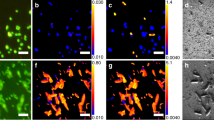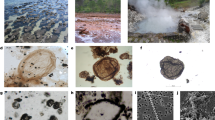Abstract
Discovery of bacteria that remain viable in a dormant state for lengthy periods is significant for understanding patterns of microbial diversity and evolution on Earth, as well as for assessing the possibility of life's interplanetary transport by impact processes. The isolation by Vreeland et al.1 of viable 250-million-year-old bacteria is an extraordinary claim, based on meticulous extraction from evaporite deposits of the Delaware Basin. If valid, this discovery expands dramatically the maximum proposed age for microbial survivability. Here we argue that, although the Permian age of these well-documented deposits is not in question, the fluid inclusions and the viable bacterial spores contained in them may represent much more recent features. The age of these microbes must therefore remain uncertain.
Similar content being viewed by others
Main
Vreeland et al. describe commonly accepted primary evaporite textures and structures — fine-scale fluid inclusions and bedded halite, for example — that are suggestive of the original depositional environment. But these observations are not pertinent to the question at hand because bacterial samples were not obtained from halite displaying such primary features. Instead, bacterial spores were extracted from dissolution pipes of “coarse, clear halite with fewer, but larger, fluid inclusions”. The authors claim that these dissolution pipes are contemporaneous with primary halite, because the coarser crystal pipes “are overlaid by undisturbed (presumably primary) halite beds”: however, this observation is not sufficient to establish the age of the fluid inclusions.
The large, clear, single-crystal nature of the halite selected is not typical of primary halite deposition. Such coarse halite is more commonly associated with processes that occur after — sometimes long after — initial deposition. For example, evaporites of the Delaware Basin have large crystal-lined cavities, which almost certainly formed in a quiet, post-depositional subsurface environment2. Coarse halite with fluid inclusions may also form by the dissolution and recrystallization of primary halite. Such recrystallization can occur repeatedly in a salt body through interaction with new pulses of fluid, including bacteria-bearing groundwater from above or below.
Almost all bedded salt contains at least some healed fractures, not always readily visible even by optical microscopy, along which fluids have moved3. These moving fluids may produce pipe-like masses that crosscut many beds — features similar to the those described by Vreeland et al. — and such dissolution and reprecipitation may take place much later than the primary deposit. Superposition of undisturbed salt beds is therefore insufficient to show that the bacteria-bearing halite dissolution pipes and their fluid inclusions are contemporaneous with primary depositional features.
Compositions of fluid inclusions from Delaware Basin evaporites also suggest multiple sources and ages, calling into question the supposed age of 250 million years. Petrographic studies and chemical analysis of large (about 1 mm) fluid inclusions in clear 'recrystallized' salt (as sampled by Vreeland et al.) show these fluids to be complex bitterns, which result from multiple diagenetic processes at unknown times3. This history is evident from the absolute concentrations as well as the ratios of halogen, alkali and alkaline-earth ions4,5. These compositions vary significantly in adjacent inclusions, often separated by less than 1 mm, and are almost always far from ion ratios obtainable by simple evaporation of sea water. Furthermore, isotope studies of such fluid inclusions from the Delaware Basin suggest that mixture with both ancient and modern meteoric waters has occurred6.
We conclude that, in the absence of primary growth features in the specific halite crystals studied, the age of those crystals and their fluids must remain in doubt.
References
Vreeland, R. H., Rosenzweig, W. D. & Powers, D. W. Nature 407, 897–900 (2000).
Shlichta, P. J. Geol. Soc. Am. Sp. Paper 88, 597–617 (1968).
Roedder, E. Am. Mineral. 69, 413–439 (1984).
Roedder, E., d'Angelo, W. M., Dorrzapf, A. F. Jr & Aruscavage, P. J. Chem. Geol. 61, 79–90 (1987).
Bein, A., Hovorka, S. D., Fisher, R. S. & Roedder, E. J. Sedim. Petrol. 61, 1–14 (1991).
O' Neil, J. R., Johnson, C. M., White, L. D. & Roedder, E. Appl. Geochem. 1, 265–271 (1986).
Author information
Authors and Affiliations
Corresponding author
Rights and permissions
About this article
Cite this article
Hazen, R., Roedder, E. How old are bacteria from the Permian age?. Nature 411, 155 (2001). https://doi.org/10.1038/35075663
Issue Date:
DOI: https://doi.org/10.1038/35075663
This article is cited by
Comments
By submitting a comment you agree to abide by our Terms and Community Guidelines. If you find something abusive or that does not comply with our terms or guidelines please flag it as inappropriate.



